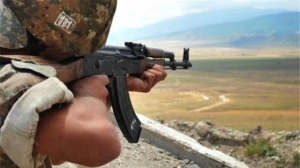New Tensions in Nagorno-Karabakh
YEREVAN - Armenian and Azeri forces have repeatedly violated a ceasefire agreement reached in Moscow on April 5 that ended four days of intense fighting between the two bitter adversaries, according to various independent media reports.
Heavy artillery exchanges and infantry skirmishes along the 20-year-old ceasefire line that separates Armenian and Azeri forces in the disputed South Caucasus region of Nagorno-Karabakh restarted March 25. The exchanges later escalated into intense days of fighting – the worst since a 1994 ceasefire ended a three-year bloody conflict over the region.
Both sides accuse each other of the recent ceasefire violations. Nagorno-Karabakh's ethnic Armenian defense forces claim Azerbaijan's front line troops fired on their positions with high caliber mortars and howitzers.
The Armenians claimed in a series of official statements to the press that Azerbaijan’s artillery intentionally targeted Armenian military positions as well as civilian settlements in Karabakh’s northeastern towns of Martakert and Mataghis.
According to Azerbaijan's claims, Armenian forces retaliated with targeted strikes on Azeri positions that “caused considerable losses of enemy personnel and military hardware.”
Azerbaijan, however, vehemently denied the claims, saying Armenian troops opened fire with heavy artillery barrages on its frontline military positions and the nearby civilian-populated villages of Terter and Gapanli. Azeri news portal haqqin.az claimed Armenian forces had severely damaged an electric power station in Terter in a recent bombardment, leaving 11 villages without electricity.
The Armenians also claimed three of their soldiers were killed this week in light skirmishes with Azeri forward operating units.
Azerbaijan did not report any casualties this week.
The US and Russia have repeatedly called on the warring sides to halt the lethal exchanges immediately and return to their pledged commitments under the April 5 ceasefire agreement.
Troubled Past
Landlocked Nagorn0-Karabakh, an ethnic Armenian exclave surrounded by Azerbaijan, has been under Yerevan’s control since a bloody two-year separatist war that killed an estimated 40,000 people and left more than a million as refugees ended in 1994.
Placed within the boundaries of the Azeri SSR by Soviet leader Joseph Stalin in an attempt to suppress nationalism in the Soviet Union’s titular republics, Nagorn0-Karabakh became a flashpoint for ethnic violence in the final years of the Soviet Union.
Armenians, who made up 80 per cent of the population at the time, attempted to wrestle the region back from Azerbaijan in the late 1980s during Soviet President Mikhail Gorbachev’s liberalizing Perestroika period.
The Christian Armenian population claimed they were subject to a growing number of discriminatory policies enacted by the local Muslim Azeri minority, who then dominated the local police and Communist Party apparatus.
Deadly clashes broke out between the communities in 1988-1991, reaching their peak in February 1988 when Azeri mobs killed at least 26 Armenians in Sumgayit, a drab industrial Soviet suburb outside Baku.
The incident caused mass civil unrest in the city and later forced Gorbachev to send units of the army as well as Soviet MVD interior ministry troops into the city to quell the violence.
As the Soviet Union imploded, open warfare broke out between the two communities in late 1992.
Allied to Russia and heavily supported by volunteers from its vast diaspora in the West, Armenia’s superior forces quickly overran and routed Azerbaijan’s poorly trained, Turkish-supplied army in 1992-1993.
Both sides later faced accusations of ethnic cleansing and war crimes, including the April 1992 massacre of more than 100 ethnic Armenian civilians in Maragah and the slaughter of 160 Azeri villagers in Khojaly in February 1992.
By the end of the war, the overwhelming majority of Azeris fled the region as refugees.
An uneasy ceasefire brokered by Russia, the US and France in 1994 left Nagorno-Karabakh under Armenian control, but years of wildly unsuccessful negotiations headed by the Organization for Security and Cooperation in Europe have left the tiny mountainous region a highly militarized breakaway separatist state, with its status still unresolved.
By Karen Tovmasyan
Edited by Nicholas Waller
Photo: AFP












